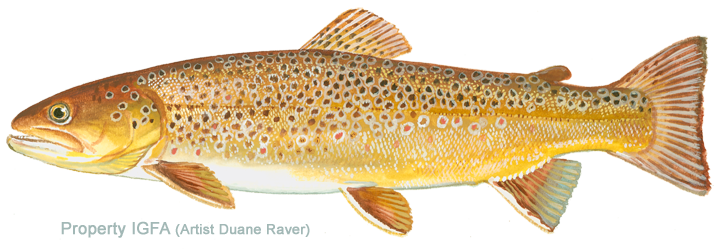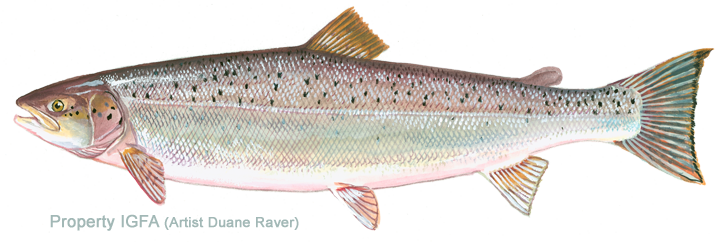Game Fish Identification Reference Guides
Trout, brown
(Salmo trutta)
(Salmo trutta)

Linnaeus, 1758; SALMONIDAE FAMILY; also called German brown trout, European brown trout, sea trout, lake trout, brook trout, river trout, bull trout, English trout, von Behr trout, Lochleven trout, German trout, breac, gealag, brownie
Native to Europe and parts of Asia, from Afghanistan and the Aral Sea across Europe to the British Isles and Iceland, and back across Scandinavia to Poluostrov Kanin (Cape Kanin), in Russia, on the Barents Sea. It has been introduced in other areas, notably, Newfoundland, Canada, U.S.A., South America, New Zealand, and Africa. Today it is found throughout the U.S.A. in the Great Lakes area, south in the Appalachians to the northern edge of Georgia, south in some high gradient streams and rivers of the Mississippi River drainage system, throughout much of Nebraska, and in every state west of Texas and Nebraska to the Pacific coast.
It resembles its relative, the Atlantic salmon (Salmo salar). Despite the historical common names “salmon” and “trout”, these two species belong to the same genus Salmo (see Salmon, Atlantic). Both have black spots on the back, upper sides, and on the gill cover, and sometimes have red spots. In fresh water especially near spawning time, both species are bronze to dark brown in general coloration, with black and (usually) red spots on the body and head. In salt water both species tend to become silvery with fewer black spots and no red spots.
Though both often occur in the same areas, they can usually be distinguished without laboratory analysis. In fresh water, brown trouts as a rule, are more heavily spotted than Atlantic salmon and usually a good number of these spots are surrounded by lighter halos. The spots on the Atlantic salmon have no halos and usually some of the spots will take the shape of X's or Y's, which is not usually the case in the brown trout. The brown trout also has dark spots on the dorsal and adipose fins and vague spots on the tail, though nothing like the prominent radiating spots on the tail of the rainbow trout (Oncorhynchus mykiss). The Atlantic salmon has no clear spots on any of these fins. Also, the brown trout's tail is squarish or very slightly concave or convex, while the Atlantic salmon's tail is slightly forked or indented. In juveniles the difference is much more obvious. The tail is slightly forked in the brown trout and deeply forked in the Atlantic salmon. Otherwise, these parr (young Salmonids) look very much alike with small exceptions. A positive distinction between these two species, usually observed in the laboratory, is that the brown trout has well developed vomerine teeth in a double zigzag row, while the Atlantic salmon has only a single row of poorly developed vomerine teeth.
The brown trout, like the Atlantic salmon, is one of the world's most widely distributed and highly esteemed freshwater (or anadromous) fish. It is a prime target of fly fishermen and one of the most difficult of trouts to catch by any angling method. It will sometimes be spooked by the bait or fly and at other times it will simply ignore it.
They sometimes hybridizes with the brook trout (Salvelinus fontinalis) producing a strikingly marked fish called a tiger trout. Few of the eggs or hatchlings of this cross survive due to genetic differences between the two genera, and the offspring is unable to reproduce
Native to Europe and parts of Asia, from Afghanistan and the Aral Sea across Europe to the British Isles and Iceland, and back across Scandinavia to Poluostrov Kanin (Cape Kanin), in Russia, on the Barents Sea. It has been introduced in other areas, notably, Newfoundland, Canada, U.S.A., South America, New Zealand, and Africa. Today it is found throughout the U.S.A. in the Great Lakes area, south in the Appalachians to the northern edge of Georgia, south in some high gradient streams and rivers of the Mississippi River drainage system, throughout much of Nebraska, and in every state west of Texas and Nebraska to the Pacific coast.
It resembles its relative, the Atlantic salmon (Salmo salar). Despite the historical common names “salmon” and “trout”, these two species belong to the same genus Salmo (see Salmon, Atlantic). Both have black spots on the back, upper sides, and on the gill cover, and sometimes have red spots. In fresh water especially near spawning time, both species are bronze to dark brown in general coloration, with black and (usually) red spots on the body and head. In salt water both species tend to become silvery with fewer black spots and no red spots.
Though both often occur in the same areas, they can usually be distinguished without laboratory analysis. In fresh water, brown trouts as a rule, are more heavily spotted than Atlantic salmon and usually a good number of these spots are surrounded by lighter halos. The spots on the Atlantic salmon have no halos and usually some of the spots will take the shape of X's or Y's, which is not usually the case in the brown trout. The brown trout also has dark spots on the dorsal and adipose fins and vague spots on the tail, though nothing like the prominent radiating spots on the tail of the rainbow trout (Oncorhynchus mykiss). The Atlantic salmon has no clear spots on any of these fins. Also, the brown trout's tail is squarish or very slightly concave or convex, while the Atlantic salmon's tail is slightly forked or indented. In juveniles the difference is much more obvious. The tail is slightly forked in the brown trout and deeply forked in the Atlantic salmon. Otherwise, these parr (young Salmonids) look very much alike with small exceptions. A positive distinction between these two species, usually observed in the laboratory, is that the brown trout has well developed vomerine teeth in a double zigzag row, while the Atlantic salmon has only a single row of poorly developed vomerine teeth.
The brown trout, like the Atlantic salmon, is one of the world's most widely distributed and highly esteemed freshwater (or anadromous) fish. It is a prime target of fly fishermen and one of the most difficult of trouts to catch by any angling method. It will sometimes be spooked by the bait or fly and at other times it will simply ignore it.
They sometimes hybridizes with the brook trout (Salvelinus fontinalis) producing a strikingly marked fish called a tiger trout. Few of the eggs or hatchlings of this cross survive due to genetic differences between the two genera, and the offspring is unable to reproduce













